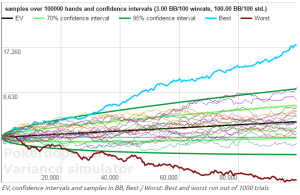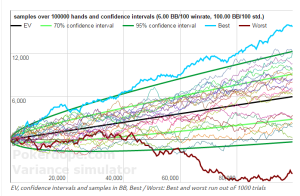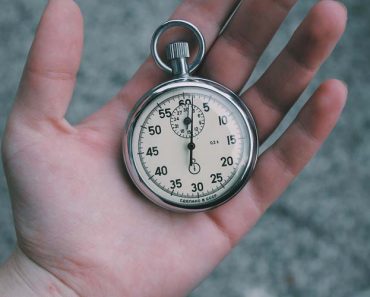Has anyone ever seen the movie ‘Rounders'?
If you haven't you definitely should.
In this movie, Matt Damon or Mikey made a huge mistake at the beginning of his poker career which nearly cost him his livelihood. Check out this video and see what we mean:
Can you spot it?
He risked his whole ‘bankroll' on the table at once.
That's suicidal in the poker world. You are almost guaranteed to go broke playing this way, no matter how good you are.
How we negate the risk of going broke to almost zero?
Well, bankroll management!
Forget all the complicated Holdem strategy and get the easiest part of the game right first!
Table Of Contents
- Bankroll Management And Why You Should Use it
- Basic Bankroll Management Strategy
- Variance Real Life Example
- Variance Calculator
- The Effect Of Winrate On Variance
- The effect of sample size on winrate
- The risk of ruin
- The bankroll management strategy
- Bankroll management strategy in action
- Bankroll Management Tips
- Closing Words
Bankroll Management And Why You Should Use it
All poker players, beginner or professional, should have an amount of cash which is ‘ring-fenced’ for poker use. The location of the cash isn't significant; once you either have it on the poker site or a bank account which can be easily accessed.
If you are a new player this might mean depositing anywhere in between $50-$500 and hold your ‘roll’ on the poker site. You should deposit as much as you can afford in order to take advantage of first deposit bonus. These bonuses can oftentimes double your deposit or more depending on the poker site and deals available at the time.
A large bankroll is a buffer for a poker player – and building a bigger bankroll should always be one of your goals. It ensures that even during an extremely bad run of cards there are sufficient funds available to the player that he or she can keep playing despite the downswing. A bankroll is basically to the capital investment required to start a business and the cash flow required to keep it up and running.
If a business doesn’t have sufficient cash flow it will no longer pay its creditors as they fall due, and it will eventually go bust. A similar situation will occur with a poker player who doesn’t follow correct bankroll management: the swings, which are an inherent part of poker, will eventually catch up.
A bankroll is basically to the capital investment required to start a business and the cash flow required to keep it up and running. If a business doesn’t have enough cash flow it will no longer pay its creditors as they fall due, and it will eventually go bust. A similar situation will occur with a poker player who doesn’t follow correct bankroll management: the swings, which are an inherent part of poker, will eventually catch up.
What we will try to achieve with bankroll management is to reduce the chance that we will go broke due to bad downswings. In poker terms, that means reducing our risk of ruin.
Basic Bankroll Management Strategy
That brings us to what is a good bankroll management strategy. Well, that is a very broad question and one I will try and answer in this post. But the main point to take home is that every player is different; thus their bankroll management strategy will vary accordingly. There is no clear-cut answer.
A very rough rule of thumb says that you should at least have 20 buy-ins (BI) for any stake that you will play. But this is the lower limit.
For example, if we wanted to play 100nl, we would require at least $2000 to reduce our risk of ruin to an ‘acceptable’ level. But the risk of ruin is also dependent on your win rate which makes pinning down an actual number quite difficult. The higher your win rate the lower your bankroll requirements should be.
Variance Real Life Example
When you first begin to play poker it can be very difficult to understand variance is; and more importantly, what way it affects you as a poker player. An analogy for variance can be easily understood when thinking about the flipping a coin. Coins are for the most part unbiased: meaning that when you flip a coin there is an equal chance of landing on heads or tails i.e. 50% probability.
This is verifiable in real life. Flip a coin 10 times probabilistically you should get 5 heads and 5 tails, but that always won’t occur. You might get 7 heads and 3 tails, or you might even get all heads or tails. However, if you continued to flip the coin after 1,000, 10,000 or even 10,000,000 times you would find the percentage will converge towards 50% heads and 50% tails.
Nevertheless, over the short sample size of 10 flips variance plays a large roll and can sway the results in one direction or the other. This same ‘variance’ is also present in poker. Although is much harder to visualize because poker is a more complicated game.
Variance Calculator
One way to begin to understand variance is by using a variance calculator such is found on pokerdope.com. On this website you will be asked to input a winrate, standard deviation (STD) and the number of hands:
- Winrate: we can assume a standard winrate of 3bb/100. For a 100nl game that would mean we are winning $3 for every hundred hands we play. Input your own winrate if you have it available.
- Standard deviation is a mathematical representation of how far from the mean a given sample may fall. The strict definition isn't important, just the number. A low STD will tell us that we will experience smaller ‘swings’ in poker. For the 6max games, standard deviations are usually of the order of 80-100bb/100. Full ring games are slightly lower (see fullring vs 6max for more differences between the two formats).
- The number of hands – this is a simple one. We will keep it at 100,000 hands for the time being.
When these numbers are plugged into pokerdope.com we get the following:
This may look confusing but let me explain. The black line shows the expected winrate; however much like the coin example, there will be deviations from the expected over small sample sizes. And yes, 100,000 hands isn’t even considered a large sample in this case.
The 95% confidence interval is given by the dark green lines (95% our winnings after 100,000 hands would fall between these ranges). The light green lines show the 70% confidence interval. Looking at the 95% confidence interval we can see that a small percentage of the time we can lose almost 40 BI; in the case of 100Nl would be almost $4,000.
On the other end of the 95% confidence interval, we can sometimes win over $8,000. So for a normal winrate, with a typical STD over what would have been generally considered a large sample will provide a $12,000 range of winnings for the 95% confidence interval. Variance plays an extremely large bankroll in short term results we see as a poker player.
The Effect Of Winrate On Variance
Well, what if we are to increase the winrate to double that of the original test. A winrate of 6bb/100 would be considered crushing for any stake above 5Nl.
It clear that the graph is quite different and has more of an upward slope. It also reassuring that after 100,000 the probability that we will lose is less than 3% of the time. However, the worst case scenario shows a large loss; although the probability of that occurring is very low. So it is clear that winrate has a big impact on how much ‘variance’ will affect our winnings. The larger the winrate the smaller the swings that will be experienced.
The effect of sample size on winrate
Finally what will happen when we increase the sample size to 500,000 at 3bb/100 winrate:
So even after 500,000 hands (a massive sample) we still have a probability of losing of just under 2%. Most people never play that many hands in their life and if they do it will take years if not decades. However, the chance of losing after the sample is quite small.
It is clear that a larger sample size is better than a smaller sample size for reducing variance; however, its effect is not as large as is seen by an improved winrate. We increased the winrate by two fold and increased the sample size by fivefold and found a similar effect.
Key takeaway: Concentrate on improving your winrate as opposed to playing lots of hands. Stop mass multi-tabling and start working on your game!
The risk of ruin
The risk of ruin is another way to quantify how many BI you need is using a risk of ruin calculator. If you enter your winrate, standard deviation as before and an acceptable risk of ruin you will find how many BI you need. Going broke and having no money to play with is any poker players worst nightmare; thus is it worthwhile getting used to using this calculator to understand and negate the risk.
To take our first example of 3bb/100 winrate with a standard deviation of 100 bb/100 we will get approximately a 5,000 bb bankroll or 50BI for a risk of ruin of 5%. For a professional that may be acceptable – but as always the larger the BR the better. If you were to choose a 20BI bankroll your risk of ruin will be greater than 25%; for a professional, this would be unacceptable and if they maintained their bankroll at this level (by withdrawing winnings) they would eventually come across a swing larger enough to make them go broke.
Moving up in stakes poses an issue for variance and is one of the reasons that moving up is so problematic for so many people. As we move up in stakes we will face higher quality players and less fish; as a result, or winrate will decrease. When our winrate drops we will experience more swings; couple the larger and more frequent swings with the fact that it is mentally demanding moving up to a higher stake (adjusting to the larger amount of money at stake). The net result: you will often find people getting stuck at a particular limit for a long period of time.
The bankroll management strategy
So hopefully you now understand why bankroll management is required. However, as mentioned there is no ‘one fits all’ BRM strategy. Your BRM strategy depends on winrate, the stakes you play, how readily you can redeposit, your mental fortitude among many other variables. But there are a few general rules you can stick to in order to get you on the right track:
- Firstly, if you are not dependent on your poker income and you have a readily available source of income which can replenish your poker bankroll well then a much smaller bankroll of 15-20 BI would suffice. This is typical of a beginning player.
- Second, if you are dependent on poker income to pay bills you need to negate the risk of ruin to close to zero. Thus you will be required to have a much larger bankroll. A professional poker player, whose sole income is from poker is recommended to have at least 60BI for their bankroll and 6 months’ rent and other bills worth of savings. It is extremely difficult to play well on the poker table if you are worried about how you will pay your rent or food for the next month. Hence, if you are in that situation, ensure you are more than well covered. Some professionals have been known to have over 100BI of a bankroll just to be extra cautious.
- For a player who is in the early stages of their poker career, it is recommended that you use a 30-40BI rule when you cannot readily replenish your poker bankroll. This will ensure that you can keep a cool head even when things aren’t going your way. Playing good poker is easier knowing that you have a big buffer sitting in your account. The lower the potential you have for refilling your account, the larger your bankroll requirements should be.
This bankroll management strategy is only for cash games. For bankroll management strategies for other game formats, we would recommend reading how to calculate tournament bankroll requirements.
Bankroll management strategy in action
Let’s take a couple of examples of good bankroll management (BRM) to drive home the point:
- “I am a beginner poker player and have less than $100 for my bankroll”: you should be looking to play the lowest stakes online. That means 2 or 5nl for cash games and 1$ or less ‘sit and go’.
- “I am a beginner but have some experience playing online and live. I have $500 for my poker bankroll”: restrict yourself to 10nl or less until you get more experience. If you are winning well at 10nl it won’t take long to move up. If you moved up to 25nl you are taking a big risk with the minimum of 20 BI which will leave you open to variance.
- “I am an experienced professional or semi-professional with $6,000 to invest in my poker bankroll and I have 10,000 in savings to cover bills for the coming months. I have no other source of income”: in this case, 100nl would be a good choice. This will give 60BI and leave plenty of room for any downswing which still having a healthy bankroll.
Bankroll Management Tips
Here are a few bankroll management tips which can help you get your bankroll building as quickly as possible:
- Make use of deposit bonuses provided by different online poker websites. When you can double your initial deposit you will quickly build a big online roll. Note: the initial deposit requires unlocking through a certain amount of play.
- When going through a rough downswing it can be beneficial to drop down in limits (before your BRM says you should) in order to get your confidence back. Taken into account what we discussed, when we drop down in stakes our winrate will increase. This will decrease variance and get us back winning as soon as possible.
- Bankroll requirements for online are significantly less than for live play. Typically the smallest limit you will be able to find live is 100Nl or 200nl. This means a beginner who is following correct BRM strategy will require upwards of $2000-$4000. This isn’t always possible. Thus use online poker as a springboard to get into live play and build up a bankroll first. Note: Live winrates are typically much larger than online so bankroll requirements can be lower. Winrates of the order of 10bb/100+ would not be uncommon.
- Stick to your BRM strategy religiously. This means if you go below your minimum BI amount you must drop down in stakes. BRM is quite easy relative to some of the more complicated poker concepts; so make sure you get the easy part down first before you work on the more difficult aspects.
- Find out how poker coaching can help you boost your bankroll with Ultimate Poker Coaching.
Check out some more bankroll management tips over at TopPokerValue.com.
Closing Words
The main reason we need to use a bankroll management strategy is simply that variance plays a large bankroll in whether we win or lose in poker over small samples. Variance can make us believe that poker is like an ATM which keeps handing us money, or in other cases that we are so bad at poker, we can barely remember the hand rankings.
Keep variance under control by employing a well thought out BRM strategy which makes sense for you personally. A good BRM strategy will also be good for your mental poker game!
If you can rigorously employ your BRM strategy you will be building the foundations for the rest of your game to grow and prosper. Concentrate on working on your game as opposed to playing lots of hands; this will reduce variance and allow you to move up as quickly as possible.
If all that made no sense, here is a nice illustration with some rough bankroll management guideline to take you all the way up to 1kNL:
Make sure you check out the fan favorite posts:
Common poker mistakes & Top Poker Tips For Beginners
Check out this BRM video below for those more visually inclined:
Any tips or comments? Please let us know.









Hi there! I am so grateful that I found your website. I really admire the dedication you put into offering the in depth information for free. I will definitely come back to your blog for more. Keep up the good work. Wish you more success, all the best!
Thanks for the comment Susanna! Glad you liked the article.
I want going to comment as this posts a bit old now, but just wanted to say thanks.
No problem, glad you liked the article.
Hello friend
The post is so helpful,it give me much help,thank you!
Thanks for the comment!